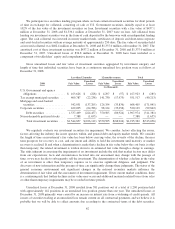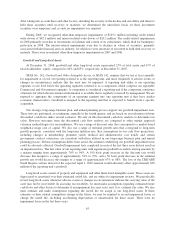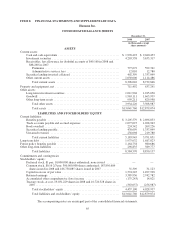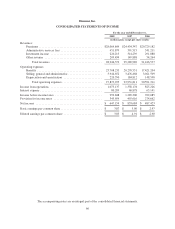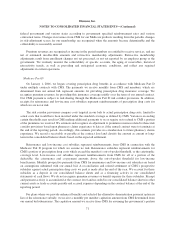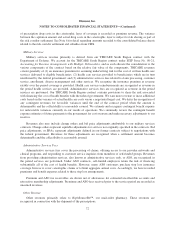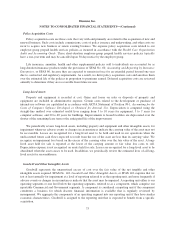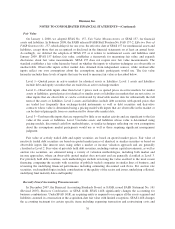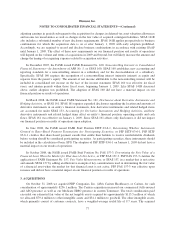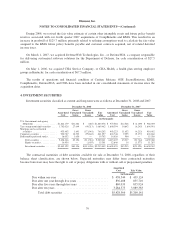Humana 2008 Annual Report Download - page 81
Download and view the complete annual report
Please find page 81 of the 2008 Humana annual report below. You can navigate through the pages in the report by either clicking on the pages listed below, or by using the keyword search tool below to find specific information within the annual report.Humana Inc.
NOTES TO CONSOLIDATED FINANCIAL STATEMENTS—(Continued)
federal government and various states according to government specified reimbursement rates and various
contractual terms. Changes in revenues from CMS for our Medicare products resulting from the periodic changes
in risk-adjustment scores for our membership are recognized when the amounts become determinable and the
collectability is reasonably assured.
Premium revenues are recognized as income in the period members are entitled to receive services, and are
net of estimated uncollectible amounts and retroactive membership adjustments. Retroactive membership
adjustments result from enrollment changes not yet processed, or not yet reported by an employer group or the
government. We routinely monitor the collectability of specific accounts, the aging of receivables, historical
retroactivity trends, as well as prevailing and anticipated economic conditions, and reflect any required
adjustments in current operations.
Medicare Part D
On January 1, 2006, we began covering prescription drug benefits in accordance with Medicare Part D
under multiple contracts with CMS. The payments we receive monthly from CMS and members, which are
determined from our annual bid, represent amounts for providing prescription drug insurance coverage. We
recognize premium revenues for providing this insurance coverage ratably over the term of our annual contract.
Our CMS payment is subject to risk sharing through the Medicare Part D risk corridor provisions. In addition,
receipts for reinsurance and low-income cost subsidies represent reimbursements of prescription drug costs for
which we are not at risk.
The risk corridor provisions compare costs targeted in our bids to actual prescription drug costs, limited to
actual costs that would have been incurred under the standard coverage as defined by CMS. Variances exceeding
certain thresholds may result in CMS making additional payments to us or require us to refund to CMS a portion
of the premiums we received. We estimate and recognize an adjustment to premium revenues related to these risk
corridor provisions based upon pharmacy claims experience to date as if the annual contract were to terminate at
the end of the reporting period. Accordingly, this estimate provides no consideration to future pharmacy claims
experience. We record a receivable or payable at the contract level and classify the amount as current or long-
term in the consolidated balance sheets based on the expected settlement.
Reinsurance and low-income cost subsidies represent reimbursements from CMS in connection with the
Medicare Part D program for which we assume no risk. Reinsurance subsidies represent reimbursements for
CMS’s portion of prescription drug costs which exceed the member’s out-of-pocket threshold, or the catastrophic
coverage level. Low-income cost subsidies represent reimbursements from CMS for all or a portion of the
deductible, the coinsurance and co-payment amounts above the out-of-pocket threshold for low-income
beneficiaries. Monthly prospective payments from CMS for reinsurance and low-income cost subsidies are based
on assumptions submitted with our annual bid. A reconciliation and related settlement of CMS’s prospective
subsidies against actual prescription drug costs we paid is made after the end of the year. We account for these
subsidies as a deposit in our consolidated balance sheets and as a financing activity in our consolidated
statements of cash flows. We do not recognize premium revenues or benefit expense for these subsidies. Receipt
and payment activity is accumulated at the contract level and recorded in our consolidated balance sheets in other
current assets or trade accounts payable and accrued expenses depending on the contract balance at the end of the
reporting period.
For plans where we provide enhanced benefits and selected the alternative demonstration payment option in
lieu of the reinsurance subsidy, we receive a monthly per member capitation amount from CMS determined from
our annual bid submissions. The capitation amount we receive from CMS for assuming the government’s portion
71



